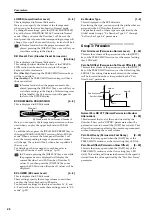
Appendices
40
○ ○ ○ ○ ○ ○ ○ ○ ○ ○ ○ ○ ○ ○ ○ ○ ○ ○ ○ ○ ○ ○
Note-on/off
Note-on [9n, kk, vv]
Note-off [8n, kk, vv]
(n: channel, kk: note number, vv: velocity)
Each time you press or release a note on its keyboard, the
CX-3 will transmit a note-on or note-off message.
Very few devices transmit note-off velocity, and the CX-3
does not transmit note-off velocity either.
○ ○ ○ ○ ○ ○ ○ ○ ○ ○ ○ ○ ○ ○ ○ ○ ○ ○ ○ ○ ○ ○
Program change / Bank select
Changing the program / bank
Program change [Cn, pp]
(n: channel, pp: program number that selects from up
to 128 sounds)
• Programs 000–127 in banks
A–H corr espond to
program changes [Cn, 00]–[Cn, 7F].
○ ○ ○ ○ ○ ○ ○ ○ ○ ○ ○ ○ ○ ○ ○ ○ ○ ○ ○ ○ ○ ○
Pitch bend
Pitch bend change [En, bb, mm]
(n: channel, bb: lower byte of value, mm: upper byte
of value, together indicating a value of 16384 steps
where 8192 [bb, mm=00H, 40H] is the center value)
The CX-3 can transmit pitch bend changes. When it
receives pitch bend changes, a pitch bend ef fect will be
applied. The range in which pitch bend will occur can be
specified by the Global mode Group 3 “MIDI P. Bend
Range” parameter.
○ ○ ○ ○ ○ ○ ○ ○ ○ ○ ○ ○ ○ ○ ○ ○ ○ ○ ○ ○ ○ ○
Control change
[Bn, cc, vv]
(n: channel, cc: control change number , vv: value)
• Contr ol changes can be turned on/off by the Global
mode Group 4 “MIDI Rx C. Change” parameter .
To silence all notes
All Note Off (CC#123) [Bn, 7B, 00] (value is 00)
When this message is received, all currently-sounding
notes will be turned off (as though all keys were re-
leased). However, any decay of the notes will remain.
All Sound Off (CC#120) [Bn, 78, 00] (value is 00)
When this message is received, all sound currently being
produced will be silenced. While the All Note Off mes-
sage allows the decay of the notes to remain, All Sound
Off causes the sound to be silenced immediately .
However, these messages are intended for use in emer-
gency situations, and are not used during a performance.
To reset all controllers
Reset All Controllers (CC#121) [Bn, 79, 00] (value is 00)
When this message is received, the values of all currently-
operating controllers will be reset.
○ ○ ○ ○ ○ ○ ○ ○ ○ ○ ○ ○ ○ ○ ○ ○ ○ ○ ○ ○ ○ ○
About system exclusive messages
Since system exclusive messages can be used by each
manufacturer as they wish, these messages are used
mainly to transmit or receive sound data or editing data
for parameters that are specific to a particular device. The
system exclusive message format for the CX-3 is [F0, 42,
3n, 5B, f f, ... , F7].
F0: Exclusive status
42: Korg ID
3n: [n=0–F] Global MIDI channel 1–16
5B: CX-3 model ID
ff: Function ID (type of message)
–
F7: End of exclusive
Each CX-3 uses the same model ID, so that exclusive data
can be exchanged between dif ferent CX-3 units.
To obtain copy of the “MIDI Implementation” which
includes MIDI exclusive format information, please
contact your Korg distributor
.
Universal system exclusive
Some system exclusive messages have of ficially defined
uses; these are called universal system exclusive mes-
sages.
Of the universal system exclusive messages, the CX-3
uses the following Inquiry messages.
Inquiry Message Request [F0, 7E, nn, 06, 01, F7]
Inquiry Message [F0, 7E, nn, 06, 02, (nine bytes), F7]
When an Inquiry Message Request is received, the CX-3
will transmit an Inquiry Message with content that
signifies “I am a Korg CX-3, system version ...”
Transmitting sound settings and other data (Data Dump)
Program and global settings can be transmitted as MIDI
exclusive messages. The action of transmitting MIDI
exclusive messages to an external device is called Data
Dump.
By performing a data dump, you can save sound settings
or other types of data on an external device, or change the
sounds or settings on another CX-3.
The CX-3 uses the following three types of data dump.
• Dump All Pr ogram, Dump Global, or Dump All
Prog+Global transmits or receives internal memory
data.
When the CX-3 receives one of these data dumps, the
data is written directly into internal memory; it is not
necessary for you to perform the Write operation.
• Dump Program transmits or receives data for the
program in the edit buf fer.
When the CX-3 receives one of these data dumps, the
data is written into the edit buffer, so if you wish to
save it in internal memory you must perform the
Write operation. The Write operation can be per-
formed on the CX-3 (refer to p.20 “Writing a pro-
gram”), or by using a MIDI exclusive Program Write
Request.
Summary of Contents for CX-3 Combo Organ
Page 1: ...Owner s Manual 4 E...



































